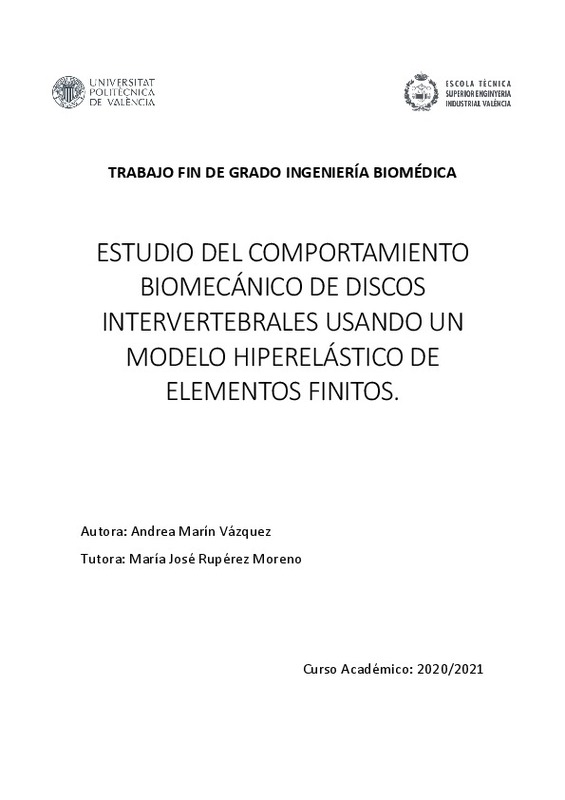JavaScript is disabled for your browser. Some features of this site may not work without it.
Buscar en RiuNet
Listar
Mi cuenta
Estadísticas
Ayuda RiuNet
Admin. UPV
Estudio del comportamiento biomecánico de discos intervertebrales usando un modelo hiperelástico de elementos finitos
Mostrar el registro sencillo del ítem
Ficheros en el ítem
| dc.contributor.advisor | Rupérez Moreno, María José
|
es_ES |
| dc.contributor.author | Marín Vázquez, Andrea
|
es_ES |
| dc.date.accessioned | 2021-07-26T14:29:35Z | |
| dc.date.available | 2021-07-26T14:29:35Z | |
| dc.date.created | 2021-07-08 | |
| dc.date.issued | 2021-07-26 | es_ES |
| dc.identifier.uri | http://hdl.handle.net/10251/170202 | |
| dc.description.abstract | [ES] Las hernias de disco en la zona lumbar son una patología que sufre un número considerable de la población, y afecta gravemente sobre la biomecánica de la columna, limitando la capacidad de movimiento y actividad natural de las vértebras y del paciente. Como propuesta para mejorar los actuales tratamientos, se va a estudiar cómo actúan las cargas sobre la unidad vertebral funcional (UVF) en su actividad natural, diferenciando entre un modelo sano y otro patológico, con disco herniado. A través del método de elementos finitos, se han modelado las UVF caracterizando al disco intervertebral con propiedades elásticas y con propiedades hiperelásticas, para analizar si las diferencias entre un disco sano o un disco herniado dependen o no del modelo usado para caracterizar su comportamiento. Mediante la aplicación de cargas se han simulado los movimientos principales de las vértebras y se han obtenido la tensión de Von Mises del anillo fibroso (AF) y núcleo pulposo (NP), el desplazamiento máximo del anillo fibroso y las rotaciones relativas de las vértebras bajo cada movimiento aplicado. Como resultados del estudio, los modelos con propiedades hiperelásticas que describen un comportamiento más parecido a la realidad, proporcionan un mayor desplazamiento del AF comparado con los modelos patológicos, donde aumenta la tensión debido a la degeneración del AF y a la deshidratación del NP. Por tanto, el método de elementos finitos es una gran herramienta para estudiar y analizar el comportamiento biomecánico de las vértebras, pero, las diversas limitaciones explicadas durante el proceso, influyen sobre los resultados y se necesita seguir investigando para mejorar las condiciones de estudio mediante este método. | es_ES |
| dc.description.abstract | [EN] Lumbar disc herniation are incredibly common diseases in the population. It seriously affects the biomechanics of the spine, having a huge impact on quality of life because of the limitation on their daily life. As a proposal to improve current treatments, we are going to study how load act on functional vertebral in its natural activity, between a healthy model and a pathological one, with a herniated disc. Through the finite element method, UVFs have been modelled characterizing the intervertebral disc with elastic properties and with hyperelastic properties, to analyse whether the differences between a healthy disc or a herniated disc depend or not on the model used to characterize its behaviour. By applying loads, the main movements of the vertebrae have been simulated and the Von Mises tension of the fibrous annulus (FA) and nucleus pulposus (PN), the maximum displacement of the fibrous annulus and the relative rotations of the vertebrae underneath have been obtained for every movement applied. As results of the study, the models with hyperelastic properties, that describe a behaviour more similar to reality, provide a greater displacement of the FA compared to the pathological models, where the tension increases due to the degeneration of the FA and the dehydration of the PN. Therefore, the finite element method is a great tool to study and analyse the biomechanical behaviour. However, the number of limitations explained during the process influence the results and further research is needed to improve the study conditions. | es_ES |
| dc.format.extent | 48 | es_ES |
| dc.language | Español | es_ES |
| dc.publisher | Universitat Politècnica de València | es_ES |
| dc.rights | Reserva de todos los derechos | es_ES |
| dc.subject | Biomecánica del disco intervertebral | es_ES |
| dc.subject | Hiperelasticidad | es_ES |
| dc.subject | Metodos elementos finitos | es_ES |
| dc.subject | Hernia de disco | es_ES |
| dc.subject | Intervertebral disc biomechanics | es_ES |
| dc.subject | Hyperelasticity | es_ES |
| dc.subject | Finite element methods | es_ES |
| dc.subject | Herniated discs | es_ES |
| dc.subject.classification | INGENIERIA MECANICA | es_ES |
| dc.subject.other | Grado en Ingeniería Biomédica-Grau en Enginyeria Biomèdica | es_ES |
| dc.title | Estudio del comportamiento biomecánico de discos intervertebrales usando un modelo hiperelástico de elementos finitos | es_ES |
| dc.type | Proyecto/Trabajo fin de carrera/grado | es_ES |
| dc.rights.accessRights | Abierto | es_ES |
| dc.contributor.affiliation | Universitat Politècnica de València. Departamento de Ingeniería Mecánica y de Materiales - Departament d'Enginyeria Mecànica i de Materials | es_ES |
| dc.contributor.affiliation | Universitat Politècnica de València. Escuela Técnica Superior de Ingenieros Industriales - Escola Tècnica Superior d'Enginyers Industrials | es_ES |
| dc.description.bibliographicCitation | Marín Vázquez, A. (2021). Estudio del comportamiento biomecánico de discos intervertebrales usando un modelo hiperelástico de elementos finitos. Universitat Politècnica de València. http://hdl.handle.net/10251/170202 | es_ES |
| dc.description.accrualMethod | TFGM | es_ES |
| dc.relation.pasarela | TFGM\142515 | es_ES |
Este ítem aparece en la(s) siguiente(s) colección(ones)
-
ETSII - Trabajos académicos [9864]
Escuela Técnica Superior de Ingenieros Industriales






